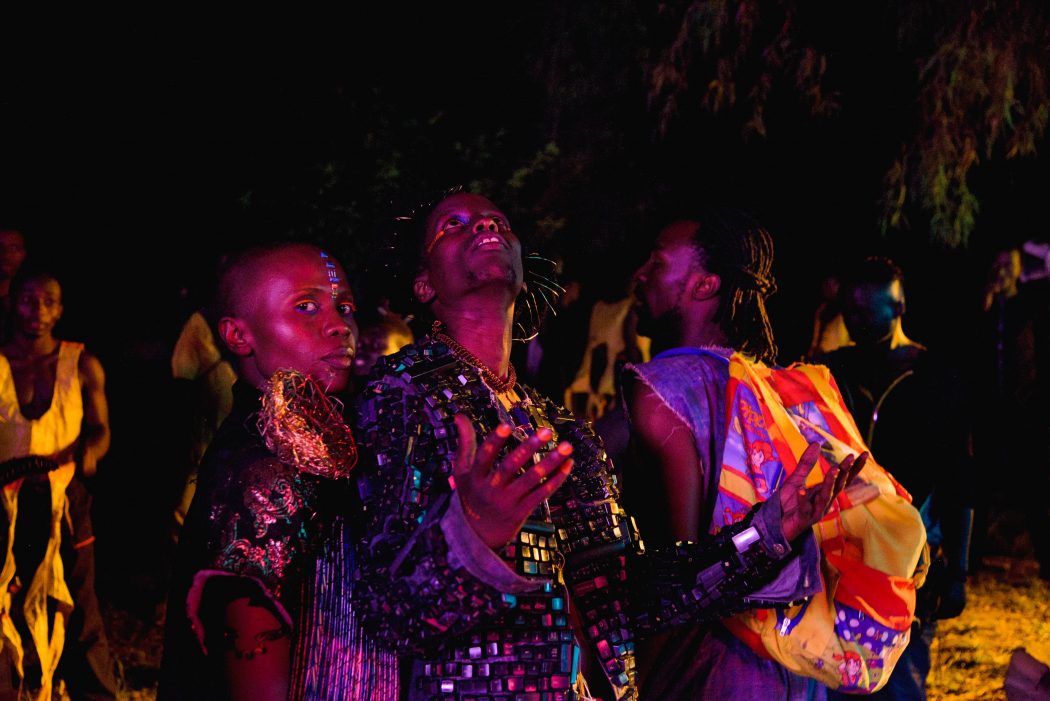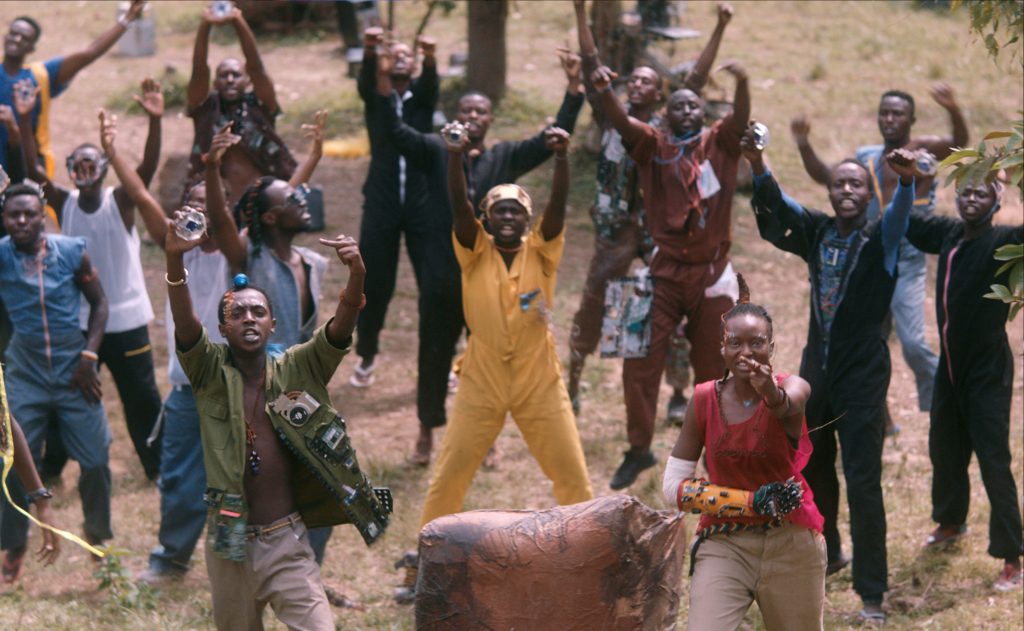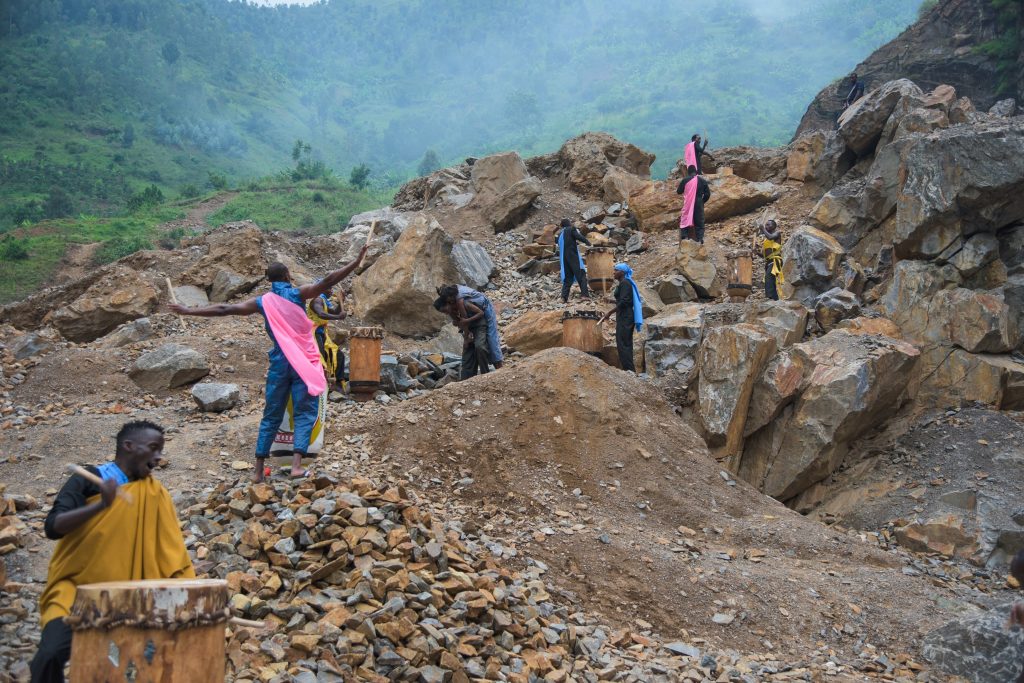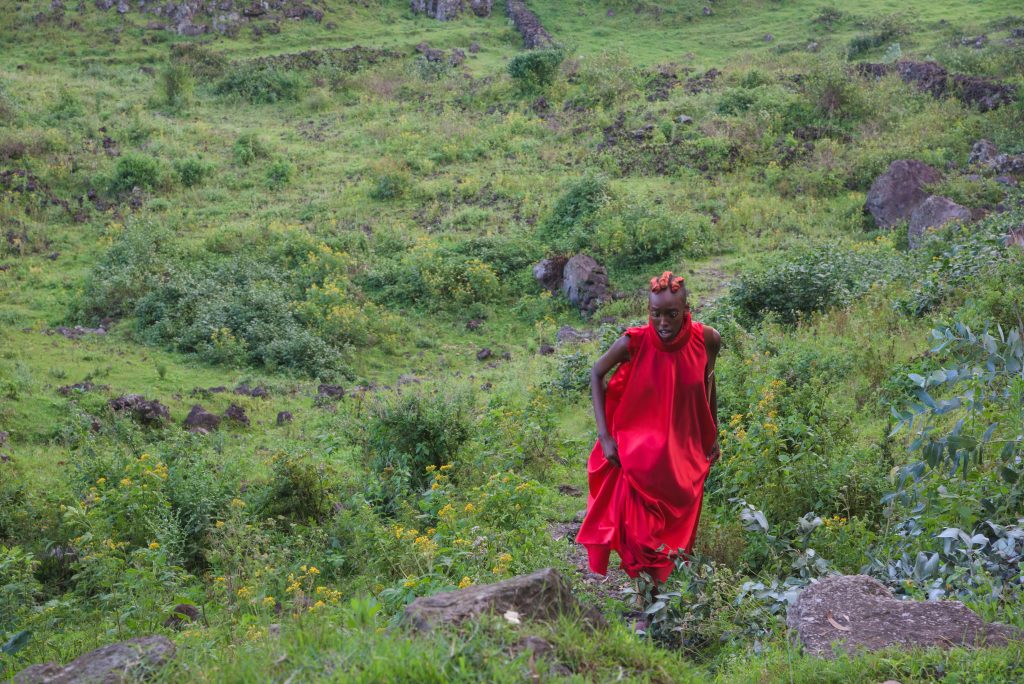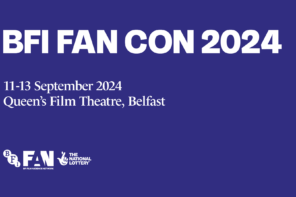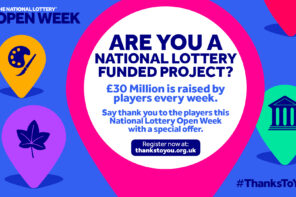Ahead of the release of Neptune Frost on 4 November, writer Edson Burton spoke to director Saul Williams about his unique futuristic vision.
On 4 November, afro-futurist fantasia Neptune Frost, a wondrous, thrilling sci-fi punk musical from multi-hyphenate, multidisciplinary artists Saul Williams and Anisia Uzeyman is released into UK cinemas. It is a sci-fi-punk musical that’s a visually wondrous amalgamation of themes, ideas, and songs that they have been exploring in their work, including on Williams’ 2016 album MartyrLoserKing. Ahead of the film’s release, writer Edson Burton spoke to director Saul Williams about the film’s themes, inspirations and why it resonates at this moment in time.
How would you describe Neptune Frost?
We described it as a science fiction musical, but the idea of the term Afro-futurism is certainly not something we’re opposed to. We wanted to do a sci-fi musical. We wanted to tell this story that connects dots between technology, gender and all of the worlds that are connected through this film, and to do it in the most creative way possible. It is a parallel world because of our relationship to technology and what we have to say about the present and its relationship to ideas connected to the future and the past.
I think it easily falls into that category of Afro-futurism and personally, I’m very inspired by that world. I grew up, as a teenager, reading Octavia Butler, and even the stuff that I liked about Public Enemy, or even the beautiful stuff that was coming out of Bristol corresponded with my idea of Futurism. It’s connected with what I felt we were heading towards and what I hoped we are heading towards. I think Neptune Frost is certainly in conversation with those ideas.
The film has been claimed by Afro-futurists and you talk about black sci-fi, but I was also fascinated by the conversation with the ‘traditional.’ I wondered if you could say something about that conversation with older Black wisdoms, ontologies, and philosophies?
That’s a huge point of inspiration for the film, especially when we talk about the avatar Potolo [played by Eric Ngangare], who in Neptune Frost visits Neptune, and Matalusa, in a dream with his beautiful wings of wheels. Potolo comes from the Dogon and means Sirius, and of course much of what is explored is inspired by ancient mythologies that cross the continent. Of course, there’s Dogon influence, there’s ancient Rwandan and Burundian influence. That relationship to the drum goes beyond a communicative device. We’re looking at the drum as the first form of wireless communication. The drum symbolises everything from the heart to being sort of like a womb and also a communicator of war.
There’s a great deal of reflection, even in relationship to gender. We have to be really clear on the fact that the rigidity that we face in present times, from relationship to gender, is a modern construct that comes very much from the colonial forces primarily through religion. That rigidity reflects more so that colonial imprint than it does any historical accuracy, because historically many indigenous cultures left room for much more than the binary.
I’m reading a book by Linda Heywood about the 16th century Angolan Queen, Nzinga and there’s some really fascinating plays around gender and gender identity, so I really loved that the film picks up these conversations.
Exactly and to me that’s a way more interesting discussion. Even when I think in terms of music, I’ve always thought that the parallels between the coding of modern technology in terms of the software that we use, that drum coding, and in particular polyrhythm as a means of finding that thing before the one and after the zero, breaks once again that binary relationship to movement and sound.
These things are futurist, but they are also ancient. I think that our attention to the ancient plays a huge role in the deciphering of the present. We’ve had conversations with some thinkers who also talked very much about Afro-presentism, where all these things that we are saying belong to the future, actually belong to now. So yes, there are many parallels to be drawn.
In the film, there’s so many references to your work – ‘Not in My Name’, ‘MartyrLoserKing.’ Where would you position this film in both yours, and Anisia’s [Anisia Uzeyman – Co-Director] creative journeys?
Thus far it’s the most absolute culmination of all these beliefs and visions and the execution of that. In the 90s, I’d write poems saying “interplanetary truth is androgynous”. All these things are there, so it’s come full circle. As we get closer and closer, and are able to tell a story, it becomes easier to pinpoint these things in the context of a story or a parable.
In relationship to my work, it’s what I’ve always dreamt of. I’m a theatre kid from New York who as a teenager dreamt of writing a musical, and when I started writing poetry I was also starting to dream of creating characters.
“I stand on the corner of the block slinging anarchist rocks” – all of these things were about trying to create these sorts of characters that go beyond the realm of my personal experience and adventure into the imagination and the dreams and hopes, which is how we communicate beyond ourselves. So, Neptune Frost allowed the space to venture deeper into that realm.
It’s also a project that’s 10 years in the making, so MartyrLoserKing, for example, was written for Neptune Frost with full understanding of what we were creating at the time. When I was writing MartyrLoserKing, it was the first step in conceptualising this story as a musical, as a science fiction story. So that was how music helped me find the voices of the characters, helped place some of the dialogue, and put some of the ideas into action. So, that album [MartyrLoserKing] comes out in 2016, we began imagining Neptune Frost, the story, in 2012. In a world where if we had gotten funding for the project in 2012, then there wouldn’t have been a MartyrLoserKing album, I would have been able to hold on to all of my ideas because I’m basically releasing my notes, so that we could live off it. Otherwise, everything would have been held on to, and would have been released as Neptune Frost and the music would have been like that. Those sounds that you hear and groundwork all throughout the MartyrLoserKing album, and also on Encrypted and Vulnerable too, was me wanting to know what Digitaria sounded like.
On Anisia’s side, we were together working in our respective realms on this vision. I could be working on sound, and she could be sourcing ideas for the colour palette, but she’s hearing the sounds. She’s a part of the creative process, we’re talking through it, we’re dancing through it, we’re joking about it, and taking our time in a way that allows us, as ideas arise, to incorporate those ideas and conversations into either the music or the dialogue of the story. Of course, there’s no way this could have come about [without Anisia]. It’s true, that on one hand, you can see elements of my work that talks about this stuff beforehand, but this particular story – how it’s told, where it’s told, would not have come about without the collaboration with Anisia. That’s what introduced me to Rwanda, that’s what introduced me to Burundi. That’s what introduced me to a lot of the ideas within the narrative, and is kind of what gave the permission to explore on my end, and the inspiration to explore telling the story here in this way, this particular story.
As we travelled together, you know, kind of dreamt out loud and shared our thoughts and histories, it just took a firmer shape. Then I really begged her to shoot it. I’d worked with her acting in her first feature, Dream States. Her relationship to the camera was very inspiring to me. Knowing where we were gonna shoot, and who we were gonna shoot was important. Her relationship to her birthplace was also going to transport something that would carry a particular level of beauty and something that’s more than a hired thing.
(Neptune Frost) was really born of our union. It’s kind of like a divine culmination of both of our visions. Of course, she’s a bit savvier on the directorial side, so that really helped sharpen the vision. Sharing that realm there, and stepping into that song together, made us stronger, made the vision clearer.
What were the elements you brought together as collaborators? What were the different and shared ones?
Working on the music, Anisia might be in another part of the house sourcing images and finding inspiration. At some point she’ll ask me to look at something and I’ll start seeing images of things built with motherboards, of different artists’ work, of architecture, of colour and costume.
It’s on finding my strength in words and sounds. It’s inspiring colours and images and ideas and that we’re able to commune with that. That was happening on a regular basis. Every day.
‘Coltan as Cotton’ really struck me and the power of coltan in the film. As an African-American, what was the experience of filming in Burundi and Rwanda? Also, with the histories that we share as diasporic people as well as being on location, seeing this modern excavation – what was that like?
The moment of learning about coltan and E-waste camps was really a revelation. I had known about the history of cotton, rubber, sugar, iron, diamonds, gold. It’s around 2010-2011 that I started learning about what’s happening with our cell phones and how they’re made, and our laptops and what makes them work, what powers them and where those materials come from.
A huge springboard for the film was making that connection with “Okay, so you’re telling me that all of this technological advancement is still based heavily on a very analogue form of exploitation?” It’s the same story.
When we went to Florida in 2016 to shoot the sizzle reel, begin the casting process, and started meeting our cast and crew, we also visited coltan facilities. We also met people who had extraordinary stories about coltan, finding it in their backyard and stuff. This served as confirmation that we were on the right path.
In response to your question, there’s a lot of source material, a lot of reading and a lot research that goes in to the process, but to put your feet there and go there and listen, and learn and see – It’s powerful. As you’re asking that question, I’m thinking about a book I recently read by Cynthia Hartman called ‘Lose Your Mother’ about an African American journey to Ghana. There’re the romantic notions that we may have, being from the diaspora, and particularly those that may not have a sense of where we’re from on the continent. Then there’s the reality, the reality of capitalism, the reality of industry, the reality of the colonial imprint, of collision, money, all of these things. That’s what Neptune Frost does, it creates a careful balance between the sort of observation that might make you throw your hands up and go “Fuck!”, and the sort of vision that allows you to push through the observation and see more, and imagine more, and to challenge and to question.
It’s reflected in some of the dialogue. You see those scenes where it’s like “We’re not sacrificed-we’re murdered.” There’s lots of dialogue in the film that throws these things in to question – how we can challenge them and how we can face the challenge, what is the most meaningful way to stand up to these forces?
What can it mean for the people who see it now, the people who maybe don’t have the privilege of travel to the extent that we may do. A lot of people in my hometown haven’t necessarily left the hometown. [They] have certain ideas of the continent that are generalised and reflect more of what’s propagated through media than anything that’s founded in reality. There’s so much beauty, like where we shot in Rwanda. People don’t know about the land of 1000 hills, how green it is, it’s like the second or third greenest country on the planet. To be able to share those images and the subtle impact that can have, to be able to explore a world different than your own. And to let go and just flow with it for the span of the time of a film, that is not layered with the same shit as films that might come from a major studio. I think these can have rich impacts on people, so for us making it and for me being there, the subtle impacts of that on my relationship to continent, history, the present is enriched and the little light grey areas begin to have a bit more colour.
Was it really important for you to tell a more complex, visually layered, idea driven story, than a traditional narrative, given you could have talked to the immediate presentism of the politics within the film?
I think that we told the story in the way that we like to hear stories told, and the way that we like to read them. I think that the hot topic of traditional forms of narrative is a hot topic because “Whose tradition?”. There’s a lot of times when I go to watch a traditional film, I’m like “Do they think I’m stupid?”, “Do they not want to leave any room for me to think, to imagine, to dream?” Does everything need to be answered up front? So, I think the film really corresponds with what we would like to see, the kind of films that we yearn for and also, the kind of films that have fed us.
There is a film-making tradition beyond Hollywood film tradition, just as there is a film tradition beyond the colonial imposed tradition even sometimes on the continent, that seeks out a sort of misrerabilist narrative. It’s like, I need to know, that there’s somebody who I can save, somebody who’s dying, a sad story. We encountered that in the critique of the film from some critics, who would be like “It didn’t show me the Africa I expected” and I don’t like that. I think we made conscious decisions to avoid miserabilism, primarily because it’s not what speaks to us. That’s not what we’re looking for in art when we look to be touched by film. So, I think the film really corresponds with the form of narrative, form of layered narrative, or simplistic, because you say it’s layered, but in some ways, I think it’s really simple.
It corresponds with what we dream of watching, we made the film we wanted to see, that’s for sure. We unfolded the story the way that we like stories to unfold, which is not to say that they can’t be unfolded in different ways. At some point, the film reveals itself, but we did make the film we set out to make. The narrative reflects the aesthetic vision that I think is found in some Asian cinema, that’s found in some African cinema that may not reflect Hollywood standards and choices, but nobody necessarily agrees that the best cinema does reflect Hollywood standards and choices.
How was the film received in Rwanda?
It’s been very exciting. We worked with primarily a new generation of artists, actors, film-makers, dancers, choreographers, visual artists, poets, musicians in the making of this film so we really were introduced to the cream of the crop of the new generation of Rwandan and Burundian artists living in Kigali and so to have that level of collaboration, the beauty on set, what we were able to explore together, for the people involved to see where we landed. Because I don’t know necessarily know if you were on set if people were like “How’s this gonna look?”
When we actually showed the film in Rwanda, I think everyone was pleasantly surprised, and beyond that, there’s also a lot of excitement because they were able to see the world’s response. The time it premiered at Cannes, or at the New York film festival, or at TIFF, or Sundance were wonderful also from our cast and crew’s perspective to go “Oh wow! The world is enjoying us!”.
Everybody in the film is a talent in their own right and works and operates as artists full time. Even in the film there’s one elder named Cecile Kayiregawa who plays a Nun and is the most beloved poet, musician from Rwanda and in many ways passes the baton to a new generation in that film.
We encountered a movement that was already in progress with artists like Cedric Mizero who nurtures a lot of visual artists who are working with this kind of zero waste aesthetic. That movement has grown, those artists feel even more solid in what they’re doing, they’re stepping out and doing more crazy stuff. The film-makers now are making more work of their own. Everybody is digging deeper in their craft. Also, in part in response to the excitement around the complete execution of this film, we wrapped on March 4th 2020, Rwanda shut down on March 8th. We shot for 5 weeks, it was really kind of a miracle that we got the film made in the first place and to be able to turn it around, so many of us artists are used to dreaming. It’s a whole other thing, and I think it’s always inspiring to artists when you reach the point of execution. I think that inspires all the artists connected, they’ll say “They didn’t just come and do it, they finished it”.
Dr Edson Burton is a writer curator- programmer based in Bristol. He is a member of the film Collectives Come the Revolution & Queer Vision & is a board member of Afrikaeye Film Festival.
Neptune Frost is out in UK cinemas on 4 November from Anti-Worlds Releasing. To book the film, email: theatrical@anti-worldsreleasing.co.uk


